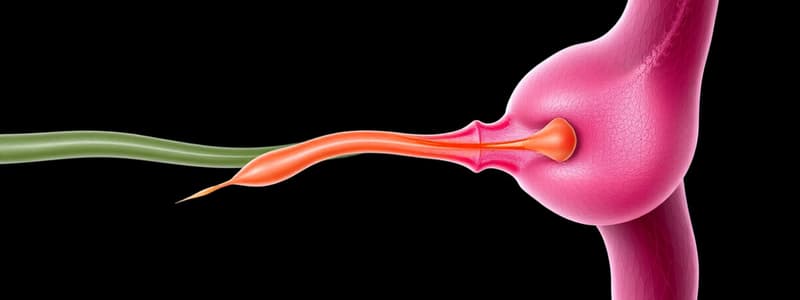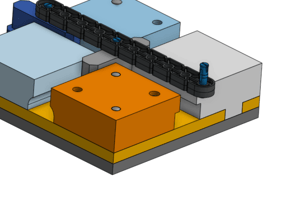Podcast
Questions and Answers
What is the primary function of the blood-testis barrier?
What is the primary function of the blood-testis barrier?
- To promote spermatogenesis directly
- To regulate temperature within the testes
- To support Sertoli cell functions
- To protect developing sperm cells from the immune system (correct)
Which of the following are the correct stages in the process of spermatogenesis?
Which of the following are the correct stages in the process of spermatogenesis?
- Primary spermatocytes, Secondary spermatocytes, Oocytes, Spermatozoon
- Spermatogonia, Secondary ova, Spermatids, Spermatozoon
- Spermatogonia, Primary spermatocytes, Primary ova, Spermatozoon
- Spermatogonia, Secondary spermatocytes, Spermatids, Spermatozoon (correct)
What is the length of the seminiferous tubules within each testicle?
What is the length of the seminiferous tubules within each testicle?
- 1500 to 2000 meters
- 100 to 500 meters
- 300 to 900 meters (correct)
- 50 to 100 meters
What role do Sertoli cells play in the seminiferous tubules?
What role do Sertoli cells play in the seminiferous tubules?
Which anatomical regions can be distinguished on the testis?
Which anatomical regions can be distinguished on the testis?
Which layer forms the covering of the testes and epididymis?
Which layer forms the covering of the testes and epididymis?
What is the average size of a testis?
What is the average size of a testis?
What is the primary role of the seminiferous tubules?
What is the primary role of the seminiferous tubules?
What primary role does the blood-testis barrier serve?
What primary role does the blood-testis barrier serve?
What type of cells form the tight junctions that create the blood-testis barrier?
What type of cells form the tight junctions that create the blood-testis barrier?
Which component does NOT belong to the interstitial tissue found between seminiferous tubules?
Which component does NOT belong to the interstitial tissue found between seminiferous tubules?
What is the primary hormone produced by Leydig cells?
What is the primary hormone produced by Leydig cells?
What function does the blood-testis barrier NOT perform?
What function does the blood-testis barrier NOT perform?
What key biological process is facilitated by the controlled exchange permitted by the blood-testis barrier?
What key biological process is facilitated by the controlled exchange permitted by the blood-testis barrier?
What is the significance of tight junctions in Sertoli cells?
What is the significance of tight junctions in Sertoli cells?
How does the structure of the testes contribute to male reproductive health?
How does the structure of the testes contribute to male reproductive health?
Flashcards are hidden until you start studying
Study Notes
Testes Overview
- Testes are male reproductive organs responsible for sperm production and male sex hormone secretion.
- They are located externally in the scrotum to regulate temperature for optimal spermatogenesis.
- Testis dimensions: plum-shaped, measuring between 4 to 5.5 cm in length.
- Structurally, each testis has an upper and lower pole, medial and lateral surfaces, and anterior and posterior margins.
Seminiferous Tubules and Spermatogenesis
- Seminiferous tubules are the functional units of the testes where sperm cell production occurs (spermatogenesis).
- These tubules are tightly coiled and interconnected, totaling approximately 300 to 900 meters in length in each testis.
- Germ cells involved in spermatogenesis include:
- Spermatogonia (the least differentiated)
- Primary spermatocytes
- Secondary spermatocytes
- Spermatids (developing into spermatozoa)
- Sertoli cells within the seminiferous tubules support and nourish germ cells, playing a crucial role in spermatogenesis.
Blood-Testis Barrier
- The blood-testis barrier is formed by tight junctions between adjacent Sertoli cells.
- It separates seminiferous epithelium from the bloodstream, maintaining a protective environment for germ cells.
- The barrier prevents immune cells and large molecules from entering the seminiferous tubules, protecting developing sperm from autoimmune responses.
- Tight junctions prevent the movement of proteins and other substances from the blood into the tubular lumen.
Interstitial Tissue and Leydig Cells
- Interstitial tissue, found between seminiferous tubules, consists of connective tissue and includes blood vessels and lymphatics.
- Leydig cells, located in the interstitial tissue, produce testosterone.
- Testosterone is crucial for developing male secondary sexual characteristics and regulating spermatogenesis.
Conclusion
- The testes feature a complex microscopic structure comprising seminiferous tubules, germ cells, Sertoli cells, Leydig cells, and interstitial tissue.
- The blood-testis barrier is essential for protecting developing sperm cells and ensuring the functionality of the male reproductive system.
Studying That Suits You
Use AI to generate personalized quizzes and flashcards to suit your learning preferences.



